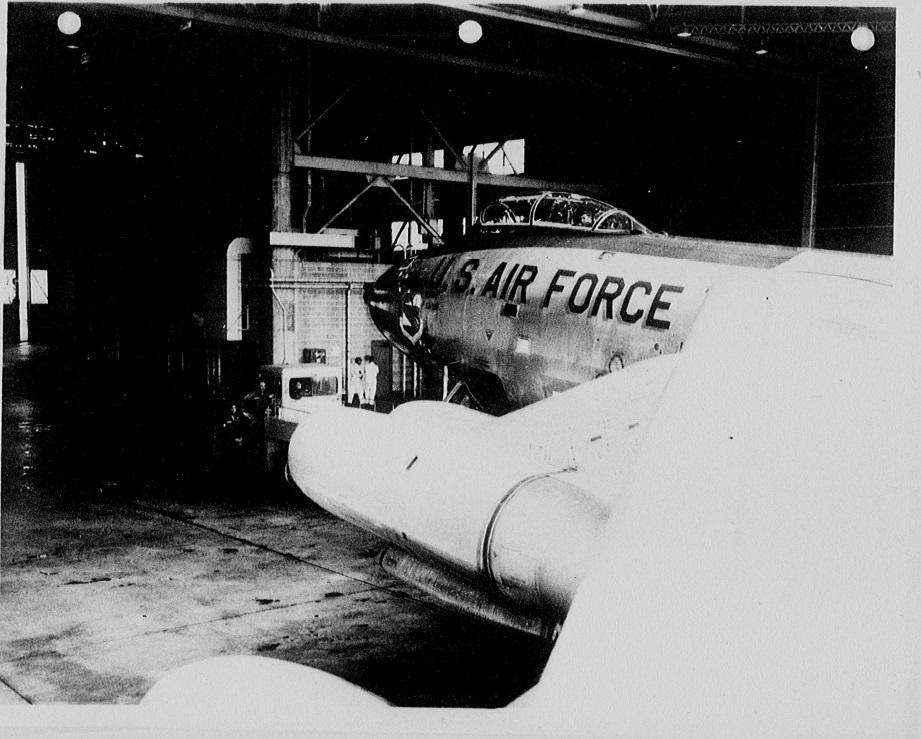Lincoln's Double-Cantilever Hangars
Today the large, tan aircraft hangars in Lincoln Air Park West dominate the skyline west of the Lincoln airport and they should standing at 98,270 square feet in size. At the time of their construction they were among the 12 largest hangars in the United States, the first built west of the Mississippi River, to receive and maintain the B-47 and KC-97. The design proved so successful that it became a dominant feature at many more SAC bomber bases.
_________________________________________________________________________________________________
Built between 1953 and December 1954, the structures design trace back to the Kuljian Corporation design that was fairly widely implemented between 1951 and 1955 when plans called for new base hangars. Lincoln's design is a "medium bomber" hangar that was specifically designed to handle four B-47s (two on each side). They were also amongst the first to be designed with nuclear blast tolerance in mind and different safety mechanisms for this purpose were built into the hangar. The masonry work was touted as "Earthquake proof" in the Jet-Scoop Base Newspaper and control joints were placed to prevent foundation cracks. Lastly, 13 independent sprinkler systems were put throughout the building and fed from an independent water reservoir not tied into the main base supply. Obviously SAC was serious about protecting its maintenance apparatus in case of attack.
Other features aimed at guarding against the frigid cold of Nebraska. These included 20 inch thick concrete floors with radiant heating employed as well as de-icing grids installed underneath the sliding doors.


B-47 6244, the last of the B-47 line under maintenance in the south hangar. Thanks Bruce Stufflebeam.
_______________________________________________________________________
To handle the immense loads of aircraft maintenance, monorail cranes were installed with a 5 ton lifting capacity (enough to lift about 10 modern pickups at once). There were two of these systems on either side of the hangar. In the middle were three shops (or islands) that were installed for OMS/FMS members to work on more intricate tasks away from the aircraft.
The door panels to the hangars measured 30 to 35 foot wide and about 60 foot tall and the hangars themselves were about as tall as a 6 and a half story building to allow for tall aircraft and the spans above. The space covered by the hangars each amounted to about 2 acres of ground.
A white paper produced by Air Force historians marks the price tag for the hangar at about 3.5 to 4.5 million dollars (which I assume means today's money, as the Jet Scoop noted construction costs at about 750,000 dollars.
The 307th Hangar (South Hangar). A classic look at the Double-Cantilever design.
Both hangars were in service by 1954 and were utilized throughout the lifespan of Lincoln AFB. As the base closed they sat empty temporarily until Goodyear Rubber leased them from the LAA and operated a Global Distribution Center there for several years. Indeed the "Goodyear" lettering sat over the hangars for many years until the operation closed in the early 2000s. Today the 307th hangar is being utilized by a business but its unknown about the 98th.
___________________________________________________________________________________________
Some more information regarding each hangar can be found in the below links
Building #956 98th Bomb Wing Hangar
Building #998 307th Bomb Wing Hangar
Citations:
COLD WAR INFRASTRUCTURE FOR STRATEGIC AIR COMMAND:THE BOMBER MISSION November 1999
Lincoln Jet Scoop Newspaper 17 December 1954